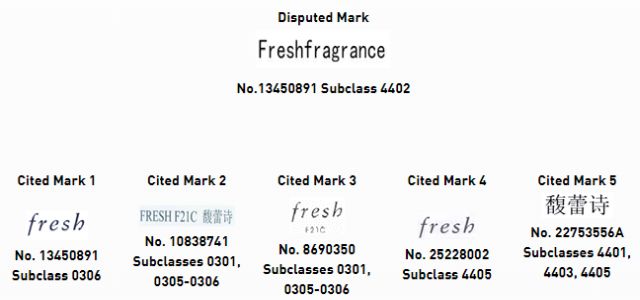In an administrative trademark invalidation dispute between the plaintiff Fresh Company and the defendant CNIPA and the third party Qiong Luo, the Beijing Intellectual Property Court held that the Disputed Mark violated Article 30, Article 31 and Article 32 of the 2013 Trademark Law. The CNIPA's decision shall be revoked and the CNIPA shall make a new ruling.

The first issue is whether the Disputed Mark filed by the third party violates Articles 30 and 31 of the 2013 Trademark Law. The court found that the Disputed Mark consists of the English letters "Freshfragrance". according to the general English cognition level of Chinese consumers, it is easy to read it as two parts: "Fresh" and "fragrance" of which the "Fresh" part is the same as the Cited Marks 1 and 4 in letter composition. It is also identical with the distinctive part of Cited Marks 2 and 3. It is similar in pronunciation to the Cited Mark 5. The Disputed Mark constitute as an identical mark with all five Cited Marks. Although all approved services such as "beauty services, massages, and manicures" for use under the Disputed Mark and the approved goods and services for use under the Cited Marks 1 to 5 are in different classes, when considering the following factors, they constitute similar marks. First, the "beauty services, makeup artist services, waxing and hair removal" and other services approved for use by the Disputed Mark are identical to the Cited Marks 1 to 5. The consumer groups of the goods and services approved for use such as "cosmetics and sanitary equipment rental" basically overlap, and are often used in combination, so they are highly related. Second, the Disputed Mark completely contains the distinctive parts of the Cited Marks 1 to 4. They are highly similar. Third, the plaintiff's "fresh/fuleishi in Chinese" series of trademarks have gained a certain reputation on "cosmetics" products through continuous publicity and use. The coexistence of the Disputed Mark and the Cited Marks may easily cause confusion and misunderstanding the relevant public. In summary, the Disputed Mark and the Cited Marks 1 to 5 constitute similar marks on similar goods and services which violated Articles 30 and 31 of the 2013 Trademark Law.
The second issue is whether the Disputed Mark violates Paragraph 3, Article 13 of the 2013 Trademark Law. The court found that the sales evidence, publicity news, comment articles, etc. submitted by the plaintiff could prove that the plaintiff's "fresh" and "Fuleishi in Chinese" trademarks had a certain degree of popularity on "cosmetics" products through use and promotion. However, after considering the scope of influence and scale of the popularity, the Cited Marks have not yet reached the level of well-known. Therefore, the filing of the Disputed Mark does not violate Paragraph 3, Article 13 of the 2013 Trademark Law.
The third issue is whether the Disputed Mark violates Paragraph 1(vii), Article 10 and Paragraph 1(ii), Article 11 of the 2013 Trademark Law. The plaintiff claimed that the word "fragrance" in the Disputed Mark means "perfume, fragrance" and its use in services such as Class 44 "beauty services and makeup artist services" can easily lead to consumers misunderstanding the content of the services. It is also a direct expression of the designated service. After hearing, the court held that the use of the word "fragrance" in services such as "beauty services and makeup artist services" can easily cause consumers to associate and believe that the services related to the use of the Disputed Mark denotes wonderful enjoyment, but such associations have not yet reach the extent of being deceptive, it does not violate Paragraph 1(vii), Article 10 of the 2013 Trademark Law. In addition, although the Disputed Mark may cause consumers' associations and imaginations, it is not a direct description of its service, so it does not violate Paragraph 1(ii), Article 11 of the 2013 Trademark Law.
The fourth issue is whether the Disputed Mark damages the plaintiff's prior trade name rights. The court found that the plaintiff had been selling "fresh/fuleishi in Chinese" brand cosmetics in China since 2012 at the latest. Through continuous publicity and use, its English trade name "fresh" has gained a certain reputation in cosmetic products. The third-party should have known that the Disputed Mark "Freshfragrance" completely includes the plaintiff's English trade name "fresh" and the two are similar in overall appearance and text composition. The approved services under the Disputed Mark such as "beauty service and make-up artist service" basically overlap with the consumer groups of the "cosmetics" goods for which the plaintiff's trade name is famous. Thus, the two mark constitute similar goods and services. Therefore, the application for registration of the disputed trademark damaged the prior right of the plaintiff and violated Article 32 of the 2013 Trademark Law.
Finally, the court held that the evidence on record was insufficient to prove that the filing of the Disputed Mark violated Article 4 and Paragraph 1, Article 44 of the 2013 Trademark Law.
The content of this article is intended to provide a general guide to the subject matter. Specialist advice should be sought about your specific circumstances.
